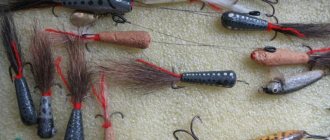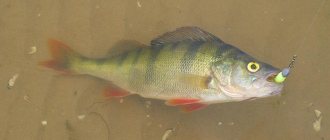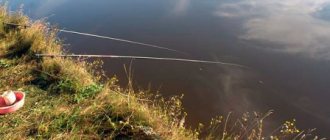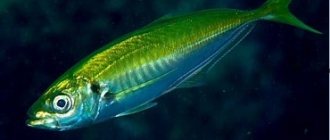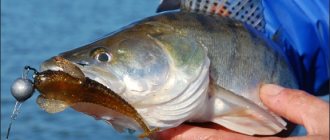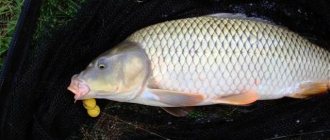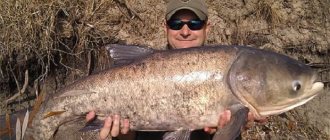Several hooks instead of one
On large jig baits, you can install up to two additional hooks (usually + double and + treble). The tee is attached using a small winding ring directly behind the jig head, and the double is closer to the tail of the vibrotail.
To do this, make a small hole in the side of the vibrotail and a longitudinal hole from its nose and in the direction of the bait to the place where we have a slot for the bait, then a double is inserted on a special leash, and passing through the cavity of the bait it comes out from the bow part, where it is attached to the eye of the jig head.
Pike perch often hits the jig head, so the tee will catch it very well, when without it the probability of hooking would be much lower.
RnR: What gear do you use for each type of bait?
A.P.: For wobblers, light jigs and retractable leash in the “premium class” I really liked the spinning rod Graphiteleader Vigore 7'4'' 1.75–10.5 g. It has an optimal length, minimal weight and excellent sensory properties make this spinning rod very convenient for fishing with a variety of baits. It is worth noting that the upper test range of this spinning rod is within 17–18 g, which significantly expands its scope. Of the more affordable ones, I liked the Banax Burst 70MLF2 spinning rod with a test range of 4–14 g. The spinning rod is most suitable for fishing with minnow and deep wobblers, light jig and retractable leash. But it is worth considering that for the latter, a length of 7 feet is considered a reasonable minimum, that is, in most cases it is already inconvenient to fish on the outlet with shorter spinning rods.
To catch pike perch with jigs and casting from the shore, we will, of course, need longer spinning rods, as they will provide a greater casting range. In general, when choosing a spinning rod with a strong emphasis on casting distance, I would recommend models with a length somewhere between 7’9” – 8’0”. In this segment, I really liked the Major Craft Rizer 792 M 7'9” 7–28 g spinning rod. It has an amazing length to casting distance ratio. This is one of the longest casting spinning rods at less than 8 feet in length. And if you also take into account its excellent “jigging sensitivity”, you get a reference model for long-distance fishing (in the “up to 81 feet” class).
Another spinning rod that I really like! when fishing with a jig and a retractable leash at long distances - Pontoon21 Sixentida 9'2” 5–18 g. The real top of the test range of this spinning rod is somewhere around 21 g. The spinning rod has phenomenal throwing characteristics, especially for lures weighing 18–20 g This is one of the few spinning rods that can cast bait to a maximum distance with minimal participation from the angler. It has a pronounced “catapult effect”. Judge for yourself: 20 g + small reel (cord 0.8) = 83-85 m. Therefore, you can fish with it for a long time without getting tired.
By the way, Sixentida is one of the recently appeared series of a special project of high-quality spinning rods Pontoon 21, the forms for which are specially made in the USA at the Lamiglas factory. For jig fishing from a boat, I have been using exclusively casting (that is, with a multiplier reel) sets of gear for several years now. An undeniable advantage is the highest sensitivity “through the fingers”.
There is no point in using short spinning rods for multicast fishing from a boat, because comfortable hooking and long, smooth casting are conveniently achieved with models over 7’6” in length. Personally, my favorite spinning rods are 8'0" - 8'6". My “favorite” is St. Croix Avid IPC 8'6” 7-21g (cast). Its upper test range is actually 30 grams. They are most comfortable to work in the entire test range.
This is very convenient, as it allows you to use one single casting kit for the entire variety of jig baits (for weights from 6–7 to 30 g). When fishing in this range of weights with a “meat grinder” we would need at least two sets.
Of the Korean manufacturers, it is certainly worth highlighting the cartoon Black Hole Classic 255 7–35 g (cast). Very good quality for minimal money.
Of the reels, I most often use the TD Zillion - a very high-torque soap dish. And among the more budget ones, definitely the Banax Lexima 110 L. I think that in this price category there are simply no competitors.
RnR: Name the best lures for catching pike perch
A.P.: When fishing at depths of up to 1 m and the presence of a current, you should choose wobblers depending on the strength of the current. Pike-perch does not like a sluggishly playing wobbler, but he also does not like the high-frequency, sweeping action of the bait. Therefore, it is important that the wobbler, in proportion to the current, is not too sluggish, but also does not vibrate too much.
As for specific models, I use: Pontoon 21 Agarron 95 SF, Ever Green M-1, Liberty LBminnow 80, ZipBaits Rigge 70 F (for relatively fast current), C'ultiva Rip'n Minnow 65 SP, Liberty Dandy 70 SP , Pontoon 21 Greedy Guts 66 SP SR (for slower currents).
If we talk about deep wobblers and deeper fishing, here are the best wobblers for me: Cultiva Rip'n Minnow 70, Duel Hardcore LB 70, Liberty Bite 60, Pontoon 21 Crackjack 58 F DR, Zip Baits Rigge Deep 70 F.
For jig baits, I prefer twisters with an average size of 3 inches and foam fish with a length of about 7–8 cm. What will be best for catching pike perch can only be determined experimentally. Each body of water is unique. Therefore, try both, accumulate statistics on a specific body of water. To cast as far as possible, I often use a “rain” wand. This bait, with the same weight of the sinker, allows you to cast 10–15 meters further.
For a retractable leader, one of the best and most stable baits is a 3-inch twister. It is good for both small pike perch and trophy specimens.
Regarding the choice of rubber color when fishing for pike perch . Here I adhere to the classic opinion: if the water is clear, I use dark baits (“machine oil”, purple), the cloudier the water, the better the shades of white work; in even more cloudy water (visibility less than 20-25 cm), lemon color turns out to be the best.
Perch, lead and jig
Photo by the author
Like any predator, it is best to catch perch in settled weather, when there are no sudden changes in pressure and prolonged rains. At the same time, the perch does not have a complete lack of bite even under unfavorable conditions, which is often the case with representatives of the capricious carp family. In the summer, perch begins to take on classic perch baits: spinners, wobblers, silicone, poppers.
Of the rotating spinners, the most widely used are the small baits “Mepps Aglia” and “Mepps Aglia Long” of numbers zero and number one. Long-type turntables have a characteristic play due to the elongated blade and, under certain conditions, work very smoothly and efficiently. But most often the classic “mepps” are used. There are exceptions when even small perch ignore miniature “spinners” and prefer larger spoons, for example, Blue Fox No. 4. Probably, the outer black coloring of such a spoon conceals the size of the bait. Perch often very excitedly grabs these baits, even being no larger than the size of a palm.
Various silicone baits, where small twisters and vibrating tails play a leading role, are also equally effective. Often, perches take these baits more willingly than various “spinners”, but everything is not smooth here: gambling “sailors” often tear off the delicate silicone tails of these baits.
With bait on a leash
The above concerns the period favorable for fishing, when the perch is active and persistent in the hunt for small fish and fry. As soon as a steady cold snap sets in, which is not uncommon in the summer, the perch almost stops taking all the listed baits. And here the so-called diverter leash often helps out. In fact, there is probably no equipment simpler and more effective than a retractable leash, which combines the technique of spinning and running donkey. However, despite its simplicity, in combination with modern baits made of edible rubber, such equipment often brings all the prey, since edible rubber attracts fish with a smell like bait. The retractable leash is also a lifesaver for a novice spinning player, since it does not require special wiring, and the process of playing the bait involves the free fall and rise of the bait due to the flexibility of the fluorocarbon cord, from which this leash is best made.
The equipment, as already mentioned, is very simple. Instead of a spoon or jig head, a weight of any convenient shape and weight is placed at the end of the braid or fishing line. As on a regular bottom, a meter-long fluorocarbon leash is tied to a loop above the sinker. The distance from the weight to the leash is approximately 20 cm. Edible rubber baits designed for perch are usually small, so you should not use an offset hook. Regular hooks up to size 6 will do. The spinning rod's action is preferable to a fast one. Twitching is also quite appropriate here. And in combination with jerking, the game of the retractable leash can be very attractive for the prickly predator.
One of the effective baits made from edible rubber is the so-called “crayfish”. At least, the bait looks very much like this bottom-dwelling arthropod. And here there will be no more mistakes like with silicone, where after an unsuccessful attack the perch simply moves away, deciding to attack again only after some time. The predator will attack the bait, which has taste and smell, again and again until it sits on the hook. Edible silicone is more of a bait. In the mentioned “cancer” two active elements are very successfully used, imitating something like tails, but the game is very reminiscent of ordinary twisters. These tails play very well when retrieved and provoke the red-finned predator to attack.
Sometimes baits of the “Hoggy Shrimp” type, also made of edible rubber, are successfully used. These are inactive baits. In them, only a few elements oscillate and seem to be moving with their legs, also reminiscent of the limbs of a crayfish or some exotic shrimp.
Jig technique
It seems that the most famous and popular fish in our waters is perch. It could be a palm-sized perch, or a real seasoned humpback whale weighing more than a kilogram. In the coastal part of reservoirs, overgrown with aquatic vegetation, it is the sailor perch that most often lives, so called for its striped color, small size and gambling agility. These perches are not very picky and picky about baits and do not require special fishing. If only the silicone bait was small. Usually, to catch such perches, a micro-jig with baits no more than two to three centimeters long is used. Thin fishing line, these miniature baits - and the bite is guaranteed. In addition, small perches are not as capricious to changes in weather as their heavier counterparts.
But catching such perches can hardly be the main goal of a spinning angler. The real catch, of course, will be the humpback perch. Most often, fishermen focus on catching it. And here you need to be prepared for the fact that large individuals of the perch herd are already mostly solitary. They avoid noisy schools of their fellows if they are not going to have breakfast with them... Perch is the same greedy cannibal as pike.
The habitats of large predators are somewhat different from the places where schools of small perch live. Most often, hardened perches are caught in snags of flooded forests of reservoirs, on the edges of pits and in river beds that have gone under water, and sometimes on spits next to channel pits. Catching large humpback whales is rarer than medium and small perch. And larger baits are used to catch them. Most often these are silicone baits about 4-5 cm long.
Silicone baits are considered effective and catchy, as they are capable of actively playing at a minimum retrieve speed. But even from rather rough silicone baits, a sophisticated Russian fisherman manages to make something like active baits using scissors. The need for invention is tricky... Small twisters and vibrating tails attract perch better, but they are also worse at “starting up”, especially at low fishing speeds. Therefore, instead of a jig head, these baits are placed on an articulated suspension with so-called “eared” weights. The bait will begin to play more actively and variedly.
But this is not enough. Too rough rubber does not allow the “tail” to make fast movements, it almost does not work. In such cases, you can heat the bait in hot water and pull it out in the “tail” area. In this place the bait will be thinner and play more excitedly. There is another way to improve the bait. To do this, you will need to change the angle of inclination of the so-called “heel” of the vibrotail. This can be done using a wood burning device or a hot nail. You just need to apply stripes or dots in the heel area and immediately after heating, move it towards a more right angle. With increased resistance of the “heel” under the pressure of water, the bait will play more actively. Another technique also improves the vibrating tail game. It is necessary to trim the “heel” with a sharp knife or blade, making it thinner and more responsive to water pressure. All these techniques are forced measures; it is better to immediately purchase high-quality baits, which, however, are more expensive.
Alexander Tokarev August 11, 2015 at 01:24
